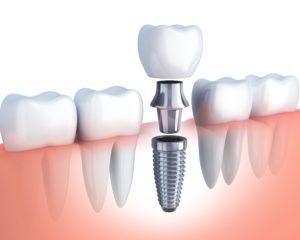
You’re ready to fix your smile, restore your confidence, and improve your oral health. You’re interested in receiving dental implants in Hamden. There’s just one problem. When you hear your dentist talking about options, it all sounded like a foreign language. You don’t know what any of those words mean. You want to understand exactly what your dentist is going to do, but you’re afraid to ask. Not to worry. We’ve made this handy guide to understanding the key terms of dental implants.
The Anatomy of a Dental Implant
There are 3 main parts that make up a dental implant:
- Implant: The base of your new tooth. It looks like a small screw and, once installed, will fuse directly to your jawbone, the way a natural tooth is.
- Abutment: A connector that will attach to the top of your implant. It will keep your implant and the crown on top in place.
- Restoration: A cap designed to look and feel like a natural tooth. This will be placed over the abutment and implant. That way, no one will notice that you don’t have your natural tooth unless you tell them.
Types of Implants
Understanding your options is always important. Here are the 3 different kinds of implants your dentist might use:
- Endosteal: The dentist or oral surgeon will surgically place small screws, plates, blades, or cylinders directly into the jawbone. This is the most common type of dental implant.
- Eposteal: An eposteal implant rests directly on the jawbone. This is not commonly used in modern dentistry, but if a patient has a high risk of bone resorption, this may be the best option.
- Subperiosteal: A metal framework is secured on the jawbone but below the gumline. The posts of this framework protrude through the gums to hold the prosthetic tooth or teeth in place. A patient might consider a subperiosteal implant if they have minimal bone height or are unable to wear conventional dentures.
What Implants are Made Of
The materials used in crafting dental implants is made to last decades, if not a lifetime. It’s important to know what type of material will become part of your body. These are the most common components:
- Many people like the aesthetic appeal of ceramic implants as they look similar to existing teeth. If a patient has an allergy to metal, they might consider ceramic. Restorations are typically made of ceramic, even if the implant itself is made of another material.
- Most dental implants these days are made of titanium. It’s a lightweight but strong metal, reducing the weight on your jawbone.
- With no prosthetic connections, zirconia implants have a lower risk of bacterial growth. Therefore, patients might experience better gum health.
Getting dental implants doesn’t have to be scary. Once you understand a little more about how they work and what they are made of, it seems a lot less confusing. Learning these terms can help you have more of a say in your future oral health!
About the Practice
At D’Andrea and Pantera, DMD, PC, we prioritize high quality care and patient comfort. Drs. Ronald D’Andrea, Robert Pantera, and Kevin D’Andrea are focused on making the patient feel relaxed as they receive the care they need. The doctors provide dental implants of all types, so if you’re interested in restoring your smile, contact them here or call (203)-288-0951.






